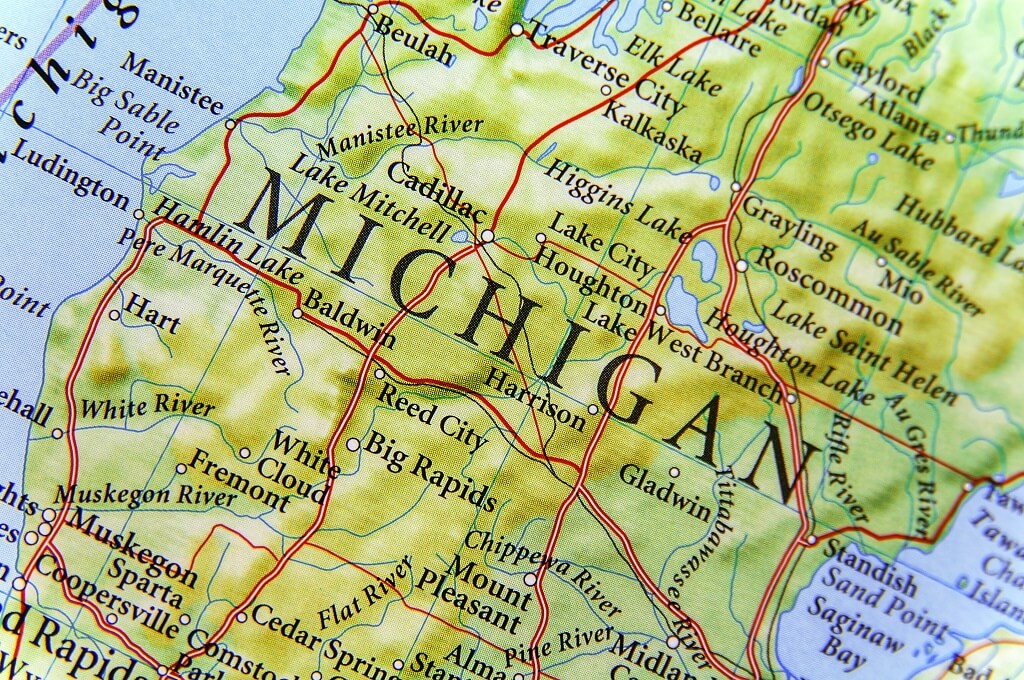When you drive down Gratiot Avenue in Roseville, there’s a monument just past Frazho road that would be very easy to miss.

Packard Field, 1929. Walter P. Reuther Library, Archives of Labor and Urban Affairs, Wayne State University.
After all, it’s painted green – the same as the surrounding bushes.
An important piece of Detroit area history was erased by a strip mall with the “greatest ratio” of parking to store area in the nation as a selling point in 1954.
That historic place ties in not only aviation, but one of Detroit’s iconic and long gone manufacturers, Packard.
That place is Michigan’s first commercial airport, Packard Field.
Best as we can find, contrary to what’s on the marker Packard Field opened in 1919 in Erin Township (part of which is now Roseville).
As a double check, looking at available 1916 maps of the area, there is no reference to an air field of any sort and the land was subdivided and held by multiple owners. The 1919 date is also corroborated by press accounts from the time.
 Airplanes once filled this sky.
Airplanes once filled this sky.
That doesn’t mean planes didn’t fly from there at an earlier date before it was named “Packard Field.” We just couldn’t find a record of it. Things sometimes do get sketchy after nearly 100 years of time passes.
The area is now heavily suburbanized and filled with mostly small two and three bedroom homes was mostly farmland.
 Early photo of Packard Field from above.
Early photo of Packard Field from above.
When it came to flying planes Packard Field was reportedly the best place to be around, and it was built as a place of experimentation for private and government projects. It was also a testing ground for Packard-built aircraft engines.
The location was conveniently half way between Selfridge field (now Selfridge Air National Guard Base) and Morrow field in Northwest Detroit (now the aptly named Aviation Subdivision neighborhood in Detroit, just west of Wyoming and south of Tireman roads).
The industry was just forming and the Detroit area was the Silicon Valley of the time – not just for cars, but anything with an engine.
 Stinson Detroiter Biplane at Ford Airport.
Stinson Detroiter Biplane at Ford Airport.
One of those advances – the innovation of three passengers and a pilot on a biplane that that had brakes on the wheels, the Stinson Detroiter – was tested and demonstrated at Packard Field, according to a Detroit Free Press article from the time.
The idea of “brakes on wheels” being an innovation tells you just how early things still were.
The design soon lost the second wing, became enclosed and was a workhorse mail carrying plane.
The Detroiter also had a special place in world history, as it was the plane that took George Hubert Wilkins on his Arctic exploration expedition of 1927.
 Truman H. Newberry. Public domain photo.
Truman H. Newberry. Public domain photo.
In 1927, the 102 acre field was purchased by a former U.S. Senator and Secretary of the Navy, Truman Handy Newberry. He purchased it for a record (at the time for Macomb County) $3,600 an acre.
Packard Field was also home to the Michigan State Aviation School (apparently a private outfit, not affiliated with what we call Michigan State University today). Many people through that operation or others received their civilian pilot licenses there beginning in 1928.
Later on in in April of 1929, Packard Field was renamed Gratiot Airport by the operator, Hartung Aircraft Corporation. Here’s a topographical map from 1940.

It would eventually get a third name, Hartung Field. Below is the last map we could find having the airport marked (it’s the gear looking icon in the middle).

Around 1954, the Eastgate Shopping Center was built on the site. It still stands to this day.
It’s a reminder of what could be. What if instead of Romulus, the main commercial airport in our region was in Roseville, just 11 or so miles away from the Detroit’s center?

What if the aviation industry had grown more in Detroit, and companies like Boeing were here today? These are question that are fun to think about but the answers we’ll truly never know. As so often in Metro Detroit, suburbia and space for a lifestyle devoted to the automobile won.

Remember the next time you’re shopping at the Ace Hardware or the CitiTrends over there, make sure to see the monument to a neat slice of Detroit area history.


